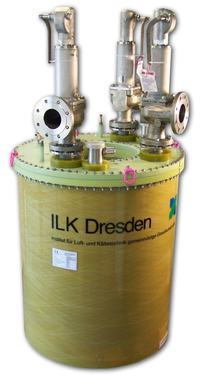You are here: / Home
Cryostats, Non-Metallic and Metallic

position indenpendent, highest endurance, tiltable for liquid helium and liquid nitrogen
Cryostats for the cooling of cryo electric components
Custom-designed cryostats made of metal and non metallic materials (e.g. glass-reinforced plastics (GRP) or carbon fiber) have been developed for cooling of sensors with liquid nitrogen or liquid helium. These cryostats have many applications and can be adapted to customer wishes. A particular achievement was the development of GRP cryostats with special properties for the cooling of iSFCLs (Inductive Shielded Superconducting Fault Current Limiter) and SQUIDs (highly sensitive magnetic field sensors). These cryostat also available as pressure vessels. Long years of experience in the designing of cryostats and the know-how necessary for their manufacture and testing are available.
product range ILK cryostats
Special features of the ILK cryostats made of GRP or metal are:
- Working temperature 4 K and 350 K, with a very high temperature stability (e.g. 3 mK by metal cryostats for the cooling of optical sensors).
- Design as pressure vessel possible (also in GRP)
- Liquid charge 250 ml up to 300 liter (in custom design up to 700 liter)
- Cooling capacity 10 to 1300 Wh (35 to 4400 BTU)
- Automatic filling and reliquefaction with sensors for monitoring.
- Low evaporation losses (Nitrogen evaporation rate < 6 % of the liquid volume per day)
- Long vacuum durability
- The leackgae rate for GRP cryostats is typical 9×10-10 mbar l / s
- HF-noise < 1 % in the range between 10 Hz and 2 MHz
- Magnetic noise < 4 fT / Hz -½
For non-destructive material testing position-independent GRP-Cryostats with an adjustable cold-warm distance (z-axis) can be manufactured. In the case of the measurement of lowest magnetic fields (heart and brain diagnostics) a displaceable x-y-position for the sensor is feasible. GRP-Cryostats, e.g. for geological surveys, can be delivered with solid insulation as well. For the laser based gas analysis with laser diode metal cryostats are needed which have a highly temperature stability of 3 mK at the sensor location.
Examples
- First position independent helium cryostat (e.g. for sensor cooling) made of GRP, with exhaust gas cooled radiation shield instead of a LN2 reservoir. 0.1 W standby heat load corresponds to 3 liter helium a day.
- First LN2 bath cryostat made of GRP for sensor cooling with a special plug instead of a neck pipe, content 35 liter – a standby vaporisation of 0.9 liter per day corrosponds to a operating time of 35 days.
- For ring cryostates made of GRP, designed as a pressure vessel without insulation on the top, a heat load less than 6 W / m² (depending on the design) is achievable. Such cryostats are suitable for the cooling of HTS componentes.
- The leackgae rate for GRP cryostats is typical 9×10-10 mbar l / s
Your Request
Further Projects
Reduction of primary noise sources of fans
...using numerical and experimental methods with contra-rotating axial fan
Software for technical building equipment
Design cooling load and energetic annual simulation (VDI 2078, VDI 6007, VDI 6020)



























